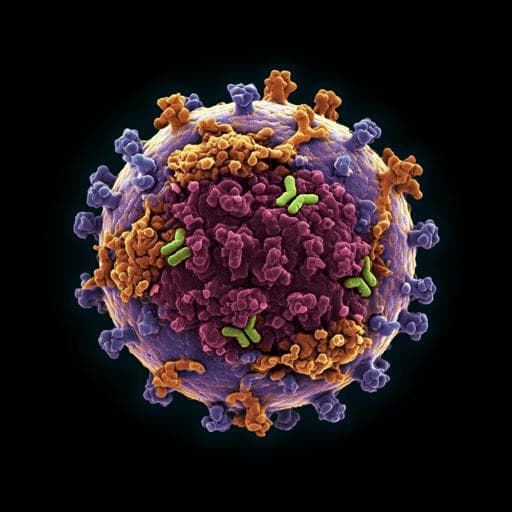
Veterinary Science
Cryo EM structures map a post-vaccination polyclonal antibody response to canine parvovirus
S. R. Hartmann, A. J. Charnesky, et al.
Explore the fascinating findings on canine parvovirus vaccination responses! Researchers, including Samantha R. Hartmann and Andrew J. Charnesky, have uncovered five unique antibodies that not only show promise in neutralizing the virus but also suggest a resilient immune response. Discover how these revelations can impact canine health!
~3 min • Beginner • English
Introduction
The study investigates how canine parvovirus (CPV) vaccination shapes the polyclonal antibody response against the viral capsid. CPV, which emerged in the 1970s via cross-species transmission from a feline virus, uses the canine transferrin receptor type-1 (TfR) for entry. Mutations at the capsid surface modulate TfR binding and host range, and these regions overlap with major antigenic epitopes (A and B sites). Prior work using rodent monoclonal antibodies (mAbs) mapped these epitopes and showed extensive capsid coverage and overlap with variable residues, but it was unclear how such mAbs relate to the canine polyclonal response following live-virus vaccination. Advances in cryo-EM and subparticle reconstruction now enable visualization of heterogeneous Fab-capsid complexes. The research question addresses which epitopes are targeted by vaccine-elicited canine polyclonal antibodies, how focused or diverse that response is, and whether antibody footprints overlap the TfR binding site, implying a mechanism of neutralization.
Literature Review
Previous epitope mapping of CPV and related parvoviruses largely used rodent mAbs, identifying dominant A and B antigenic sites via competition assays and mutation mapping. Cryo-EM of mAb Fabs revealed multiple overlapping footprints clustered around A and B, covering ~70% of the capsid surface, and coinciding with naturally variable residues. High-resolution structures of selected mAb-capsid complexes established atomic contacts. However, these rodent mAb studies may not reflect the in vivo canine polyclonal response to infection or vaccination. Recent cryo-EM techniques, including asymmetric and localized subparticle reconstruction, have enabled mapping of polyclonal responses to diverse viruses and complexes, motivating application to CPV to define the canine vaccine-elicited repertoire directly on intact icosahedral capsids.
Methodology
Two complementary approaches were used to prepare vaccine-elicited canine polyclonal Fabs and determine their capsid-bound structures by cryo-EM with subparticle analysis.
- Affinity-purified CPV-specific Fab (8-week-old male Beagle): Plasma from a puppy immunized three times with CPV modified live vaccine (MLV) was passed three times over a CPV capsid affinity column (NHS-activated Sepharose coupled with CPV-2b). Bound Ig was eluted at pH 3.0, neutralized, digested with immobilized papain to generate Fab, and Fc was removed by Protein A. CPV-2a empty capsids were incubated with the affinity-purified Fab, ultrafiltered (100 kDa MWCO) to remove unbound Fab, vitrified on Quantifoil grids, and imaged on a Titan Krios G3 with a Falcon 3EC detector (300 kV; pixel size 1.1 Å; total dose ~45 e−/Å2). 184,559 particles from 6,907 micrographs were processed in cryoSPARC (motion/CTF correction, 2D classification, homogeneous icosahedral refinement; final sharpened map 3.2 Å). Unsharpened maps showed weak asymmetric Fab density.
- Total-Fab preparation (12-week-old male Beagle): Plasma from a puppy immunized four times with CPV MLV was processed over Protein A/G to isolate total Ig, papain-digested, and Fab purified by mixed-mode chromatography (Ceramic Hydroxyapatite Type I) using a phosphate gradient, buffer exchanged to PBS, and frozen. Total Fab was incubated with CPV capsids; complexes were concentrated and washed via 100 kDa MWCO filtration to remove unbound Fab, then vitrified and imaged similarly. 322,846 particles from 8,124 micrographs yielded an icosahedral reconstruction to 3.1 Å (sharpened), with visible Fab density in unsharpened maps.
- Subparticle extraction and classification: To resolve heterogenous Fab binding, Icosahedral Subparticle Extraction and Correlative Classification (ISECC) was used to generate subparticles from icosahedrally refined particle stacks, focusing on the A and B epitopes and the apical region above the capsid surface. For the affinity-purified dataset, 11,073,540 subparticles were generated for each site (A and B). For the total-Fab dataset, 19,370,760 subparticles were generated for each site. Initial models were built with relion_reconstruct (10,000 subparticles). Subparticles were 3D-classified and refined in RELION 3.1; DeepEMhancer was used for local sharpening.
- Model building and footprint estimation: Capsid models were initiated from PDB 2CAS; Fab variable regions were modeled using a poly-alanine version of a Fab structure (PDB 3IY0) with heavy/light orientation assigned via CDR3 positioning. Refinement was performed in ISOLDE and PHENIX real-space refinement; validation with MolProbity. Fab footprints on the capsid were estimated via map-model analysis and stereographic roadmap projections (RIVEM). Steric clashes between symmetry-related Fabs and across sites were assessed to infer maximum possible occupancy.
Key Findings
- Across both dogs/datasets, five distinct Fabs bound the capsid: two in the affinity-purified dataset (one A-site, one B-site) and three in the total-Fab dataset (one A-site, two B-site: B1 and B2).
- Affinity-purified dataset (8-week-old dog):
- A site: 21.4% of A-site subparticles contained Fab density; refined to 3.8 Å. Approximately ~12 A-site Fabs per capsid based on classification.
- B site: 21.4% of B-site subparticles contained Fab density; refined to 3.7 Å. Approximately ~12 B-site Fabs per capsid. Total bound Fabs per capsid ~25.
- In icosahedral averages, B-site Fab was barely visible due to low occupancy and local symmetry averaging; subparticle analysis was essential to detect it.
- Total-Fab dataset (12-week-old dog):
- A site: a single Fab class; 9.6% of A-site subparticles; refined to 3.6 Å; ~6 A-site Fabs per capsid.
- B site: two distinct Fab classes with different angles/footprints:
- B1: 22.5% occupancy; refined to 3.0 Å.
- B2: 22.9% occupancy; refined to 3.0 Å, with a loop of poorer density and notably shorter CDRs; Fab straddles a capsid cleft.
- Approximate per-capsid occupancies: ~13 B1 and ~13 B2; total bound Fabs per capsid ~31.
- Epitope specificity and footprints:
- All Fabs target the known A and/or B antigenic sites.
- A-site Fabs from the two dogs recognize overlapping epitopes but bind with different angles/orientations, yielding different footprints; known rodent escape residues VP2 Ser226/Thr228 lie within both A-site footprints.
- B-site: the affinity-purified B-site Fab and total-Fab B1 bind with similar angles/footprints, but with heavy/light chain orientations flipped by ~180°, indicating convergent recognition. B2 binds differently and features shorter CDRs.
- Steric occlusions:
- Affinity-purified sample: no symmetry clashes; up to 60 copies of each A- and B-site Fab could, in principle, bind.
- Total-Fab sample: A-site Fab clashes across the twofold, allowing only 30 A-site Fabs per capsid; B1 and B2 footprints overlap such that only one can occupy a given B site; B2 also clashes with the A-site Fab, lowering achievable occupancy.
- Mechanistic implication: All Fab footprints (A and B) overlap the TfR binding site, implying neutralization by receptor-blocking; any single identified antibody is likely neutralizing.
- Methodological advance: Subparticle analysis (ISECC) successfully resolved low-occupancy, heterogenous Fab binding to an icosahedral capsid at near-atomic resolution, including Fabs nearly invisible in symmetric averages.
Discussion
The study mapped vaccine-elicited canine polyclonal Fabs directly on CPV capsids and showed that, despite a polyclonal response, antibody specificity was remarkably focused: only one or two dominant Fabs per epitope (A and B) were detected per dog. Subparticle reconstruction overcame the limitations of icosahedral averaging and low occupancy, revealing discrete Fab classes and their orientations. The overlap of all Fab footprints with the TfR binding site indicates a convergent neutralization mechanism via receptor blocking, suggesting redundancy—any one of the identified antibodies could neutralize. Differences between dogs were evident at the A site (distinct angles/footprints), whereas B-site antibodies from separate animals showed similar capsid interaction geometry with heavy/light roles inverted, potentially reflecting constraints imposed by capsid topology or favored germline usage. The approach provides a realistic view of partial occupancy and steric interactions that shape antibody binding in vivo, contrasting with traditional fully saturated mAb complexes. These insights tie antibody recognition to functional sites controlling host range (TfR), with implications for virus evolution under immune pressure.
Conclusion
This work defines, at near-atomic resolution, the focused polyclonal antibody response to CPV vaccination in dogs, identifying five distinct Fabs across two animals that target the A and B epitopes and overlap the TfR binding site, implying receptor-blocking neutralization. It demonstrates that affinity purification is not required for successful polyclonal mapping and that subparticle cryo-EM (ISECC) can resolve heterogeneous, low-occupancy Fab binding on icosahedral capsids. The methodological framework should be broadly applicable to mapping polyclonal antibody and ligand interactions on other viral capsids. Future studies could extend this approach to larger cohorts, different time points post-vaccination or infection, and integrate Fab sequence information to correlate structural footprints with germline usage and maturation pathways.
Limitations
- Antibody variable domains were modeled as poly-alanine due to unknown sequences, likely underestimating contact residues and limiting detailed comparison (especially for B2 with shorter CDRs and poorer loop density).
- Small sample size (two dogs) limits generalizability; similar B-site binding across dogs might reflect coincidence or shared germline usage and cannot be resolved here.
- Partial occupancy and steric clashes complicate quantitation of maximal binding per capsid; icosahedral averaging obscured low-occupancy Fabs without subparticle analysis.
- Affinity purification may bias antibody populations and led to lower Fab concentration; however, results were consistent with total-Fab preparations.
- Lack of direct neutralization assays within this study; neutralization inferred from overlap with TfR binding site.
Related Publications
Explore these studies to deepen your understanding of the subject.







